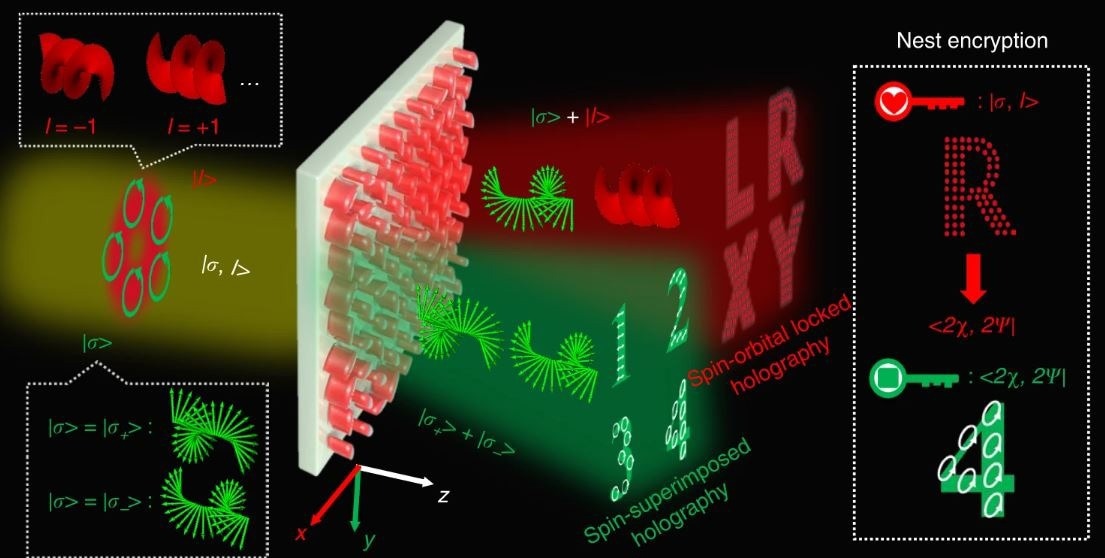Gabor’s invention of holography offers a method for capturing and reassembling the full information (i.e., strength and phase) of the light from an object. Since their development, holographic-related technologies have found extensive use in a variety of fields, including optical display, imaging, data storage, encryption, and metrology.

The AM holography depends on arbitrary superimpose the SAM and OAM eigenstates in the output field. For the spin-orbital locked holography (SOLH), the reconstruction of the four holographic images “L, R, X, Y” depends on the incident light carrying certain SAM and OAM values (indicated as |σ, l >). For the spin-superimposed holography (SSH), the four Arabic numbers “1, 2, 3, 4” with specific spatially distributed SoPs are reconstructed under the incident XLP Guassian light (indicated as |0, 0 >). For the optical nested encryption, the reconstructed SOL holographic images are used to perform as the keys (translated to certain SoPs represented as <2χ, 2ψ | , where χ and ψ indicate the ellipticity angle and azimuth angle, respectively.) of the next decryption and the encrypted information is fully unlocked by the generated SS holographic images. Image Credit: Yang, H., et al. (2023)
Researchers from Hunan University’s Yueqiang Hu and Huigao and Shenzhen University’s Zhenwei Xie created a new technique for using angular momentum (AM) holography for information multiplexing, which was recently published in the journal Light Science & Application.
Holography based on conventional optical systems, such as spatial light modulators (SLM), has a limited field of vision and poor precision, which limits its practical uses. On the other hand, by using metasurfaces in place of conventional components, researchers can reach the counterpart with high precision, ultra-thin thickness, and high performance.
Lights can be manipulated with a variety of degrees of freedom (DoFs) using metasurfaces, which are two-dimensional subwavelength arrays of nanoscale scatters. (DoFs). It offers a new breed of adaptable optical multiplexing holography systems.
In this situation, various optical properties of light, including wavelength, incidence angle, state of polarization (SoP), and time, have been used to create separate communication channels for holographic systems.
The AM dimension of light has surfaced as a new possibility for multiplexing holography, having nearly exhausted the physical dimensions currently available.
Numerous uses in the areas of conventional and quantum optical, such as optical tweezers, the spin-Hall effect, and quantum microscopy, have been made possible by the optical AM, a quantum mechanical description of the photon. Angular momentum (AM) can be categorized into orbital angular momentum (OAM) and spin angular momentum (SAM).
The implementation of OAM as a separate information carrier for optical holography uses suitable spatial frequency sampling of an image in momentum space. Due to the limitless helical mode and inherent orthogonality, OAM-multiplexed holography shows an unprecedented capacity for optical information processing.
The OAM-dependent holography is provided with the addition of linear polarization channels, further increasing the information capacity. Both spin-dependent and spin-decoupled multiplexing holography methods have been investigated using the SAM.
Full-polarization vectorial holography has been the subject of numerous endeavors. Since it can regulate arbitrary polarization vectors on the Poincare sphere (PS), it theoretically can provide an infinite number of multiplexing channels, which opens up many possibilities for high-capacity optical encryption.
There has not been any research done on concurrently changing the full-polarization vectors and adding the SAM dimension to the existing OAM-multiplexed holography.
Segmenting or combining different types of meta-atoms, each of which corresponds to a different utility, is the most intuitive design strategy. Its effectiveness will be hampered by these techniques, which will also cause unnecessary cross-talks.
An ideal solution to these issues would be a metasurface made of non-interleaved meta-atoms. The interleaved or non-interleaved methods have both shown promise, but neither has been able to fully realize AM holography.
The study team has empirically and conceptually supported the AM-holography paradigm, which is founded on the full synergy of the SAM and OAM via an easy metasurface.
The two spin eigenstates must be separately controlled and arbitrary overlays must be made in each operation channel for AM-holography to function properly. As a consequence, the resulting waveform has been thereby spatially modulated.
The study team proves the theory using an AM meta-hologram that can reconstruct two different groups of holographic images. These are the spin-superimposed (SS) and spin-orbital locked (SOL) ones, which produce the multi-dimensional and multi-channel holography dictated by the incident AM.
As a result of the additional safety features provided by the multi-channel AM meta-holograms, it was possible to build an advanced optical nested encryption platform and completely overhaul the previous optical encryption methods, which had poor security or restricted data capacity.
The optical information is encrypted and decrypted using the SOL and SS holographic images in a specific order as part of the optical nested encryption strategy, rendering the encoded data resistant to certain kinds of brute-force assaults.
To meet the increasing demand for concurrent high-security information transfer, the nested encryption method potentially possesses limitless information channels from AM holography.
It is important to note that the design strategy is generalized and can be expanded to accomplish additional waveform shaping capabilities, such as the generation of spatially structured light and polarization knots.
Journal Reference:
Yang, H., et al. (2023) Angular momentum holography via a minimalist metasurface for optical nested encryption. Light Science & Application. doi:10.1038/s41377-023-01125-2